INTERVIEW: 17+1 Artists & The Mykonian Traditional Dress
The exhibition entitled “Women’s of Mykonos Clothes: A study in Aegean Civilization”, started from 29 April until tomorrow at the Katakouzenos Foundation, is a project which as the curator Ms. Mina Karagianni explained to us: “It began in September 2014, Mr. Metzikof had started a little earlier. Each exhibition is a research project from which generated new knowledge and experience. The exhibitions that I curate follow this principle. These exhibitions raise questions and provide answers, this has to be their role. For this exhibition, I did primary research in archives. The marriage contracts and the City Testimonials from the period 1700-1800 were among the others, source of valuable information on parts and materials of the clothing. Apart from the engraving of Tournefort, there is no other evidence that records details relating to this. The marriage contracts showed Mr. Metzikof and us some ways. The research extended to all Aegean costumes, common elements were found and all the sources were used. The contact with the visual artists every time is unique. With some of them I have worked in the past and this helps both sides. Nevertheless, there is always the element of surprise. The experience to take from the visual artists what they have to give you is precious. I wish it happened always on a reciprocal status”. Their experiences of how tradition and history, influences, coexist and eventually is transformed into a contemporary artwork, shared with us all the 18 artists of the exhibition. The order of presentation of the visual artists, is not alphabetical nor hierarchical, since we consider all the artworks equal, but derives from the aesthetic and visual continuity and also the image that our magazine want to convey to the readers.
By Efi Michalarou
Photo: Mina’s Karagianni Archive
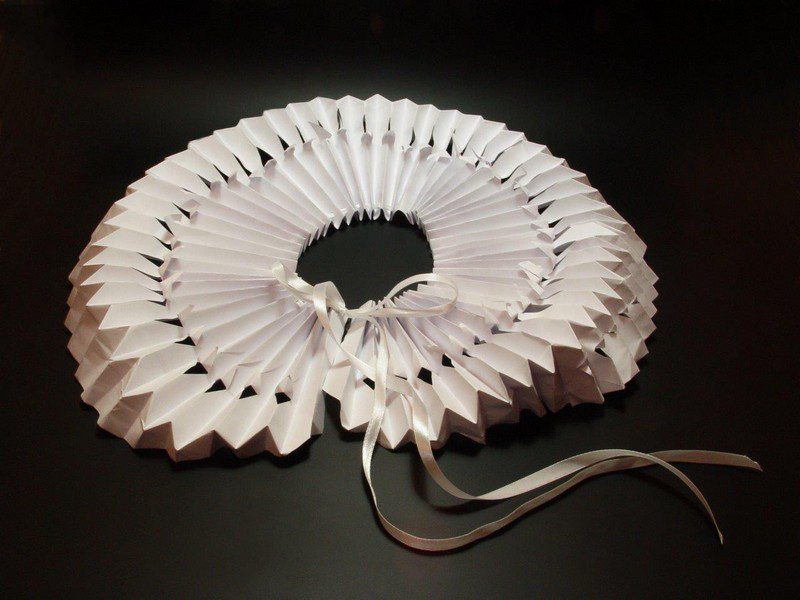
Georgia Gremouti: On the occasion of the traditional Mykonian dress, Mina Karagianni started for our group, a trip through time. Through old engravings and texts of travelers, we tried to reconstruct the image,the objects, the clothing. The contact with the curator, the artists and the climate of our meetings, played an important role in the creative process. In the weeks that followed, before the crystallization of the project, the selection of the house of Angelos and Leto Katakouzenos, acted as a catalyst in the final result. Linked the tradition of the 19th century, with the recent history of the generation of ‘30s. Constructing the paper tucker-stole, I recreate the pleat, a key element of the garment and an important part of Greek tradition, both in ancient statues and in local costumes. Fascinated by the past and desiring to incorporate the artwork into a space filled with personal items, I attempt to reconstruct history.
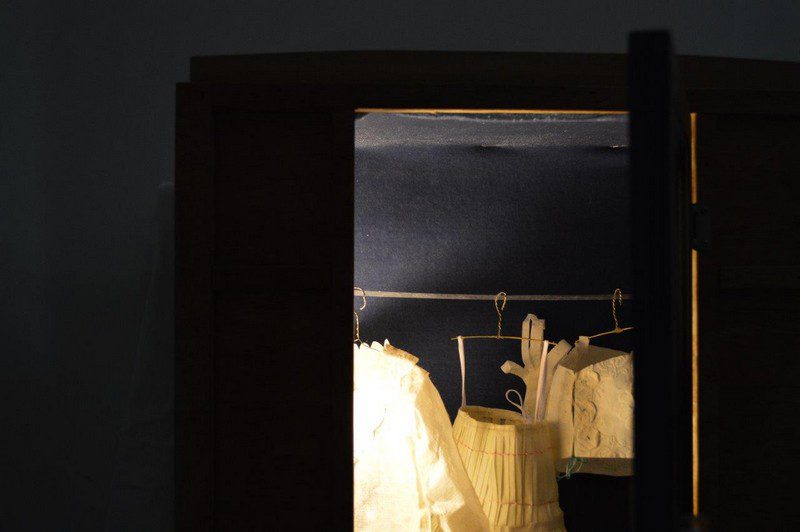
Marigo Kassi: One theme in many versions… We all worked, without to know what the other artists were doing. And the result is just so pluralistic! As long as Mr. Metzikof was looking for the materials and the ways to complete the costume, I think that we proceeded, deepening on the subject. My initial thought was to place and to illuminate the costume made of paper in two small closets, symbolically, thus expressing the collective memory of the lost outfit, since the grandmothers of Mykonos, for various reasons and their own needs, they did not preserved it. The desire of younger women of Mykonos, was to see it again. I must say, that the space of the House of Katakouzenos didn’t not left me untouched, so I used the space of the psychoanalytic clinic for the wardrobes and the beautiful sofa-arms of the waiting room for the paper shoes. An exhibition done very seriously and with great love from all of us, but especially from the curator Mina Karagianni.
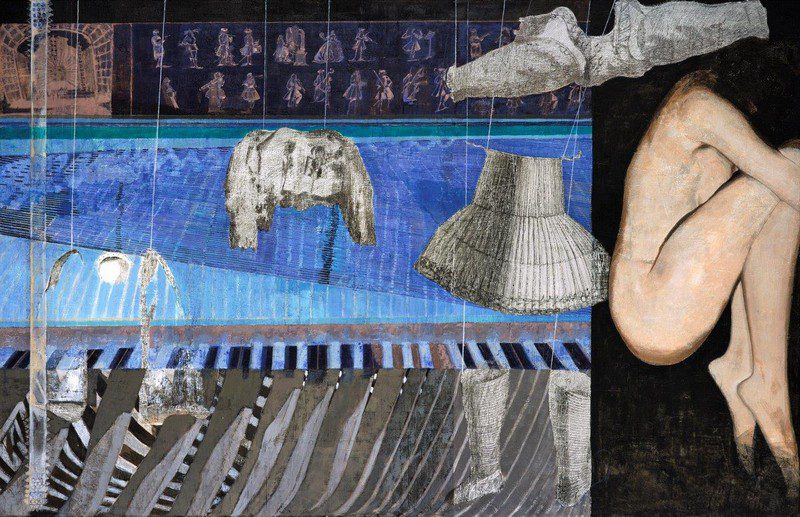
Eleni Paulopoulou: My work “Chastity Belt” It is a metaphor for the paths of female identity through the traditional garment, which is a sacred symbol for many centuries. The pieces of clothing of Mykonos Island, are swinging a little threatening in this composition, the space has a memory of dimension and contemporary woman is painted as a naked, renouncing the traditional garment, which is her traditional role. She reborn and looks for her new face in contemporary era, internalizing the entire memory and wisdom that was given to her by the time. But it is something more, is the naked regenerated body of the acquittal, is the projection of humanistic dimension, a new rebirth, existential, which is a desired, tragically topical in the era of globalization, where the sad standards of life style, are capturing contemporary people in clothes and roles prisons. Maybe I want to present, the need of a new woman, who will renegotiate all aspects of life from the beginning.
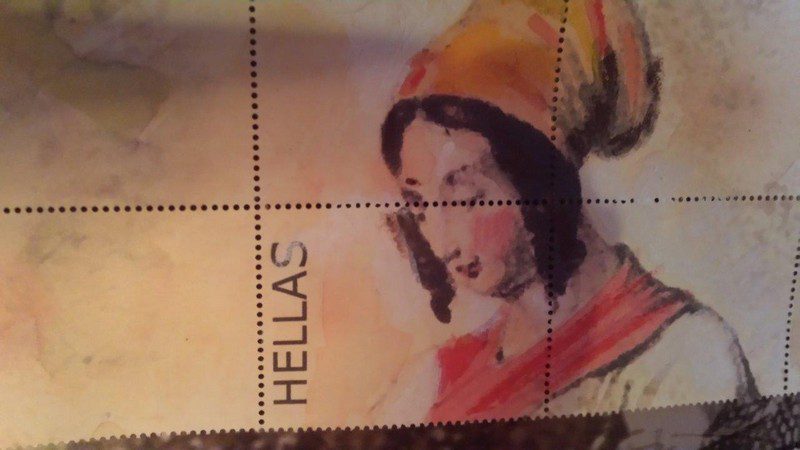
Mirsini Vardopoulou: On the occasion of this cooperation, the study of tradition and everything crystallized from this, gave the basic concept: an artwork in the form of a stamp. But the essential difference is, that instead of holding the costume into the stamp, the stamp to fit in costume. The theme was developed in perforated paper, when it was excised, created many stamps with parts of the costume. I am glad that I was a natural conduit between this idea and the stamp configuration of the artwork. Glad even more, because the small production of real stamps with the costume of Mykonos, will remind the exhibition forever.
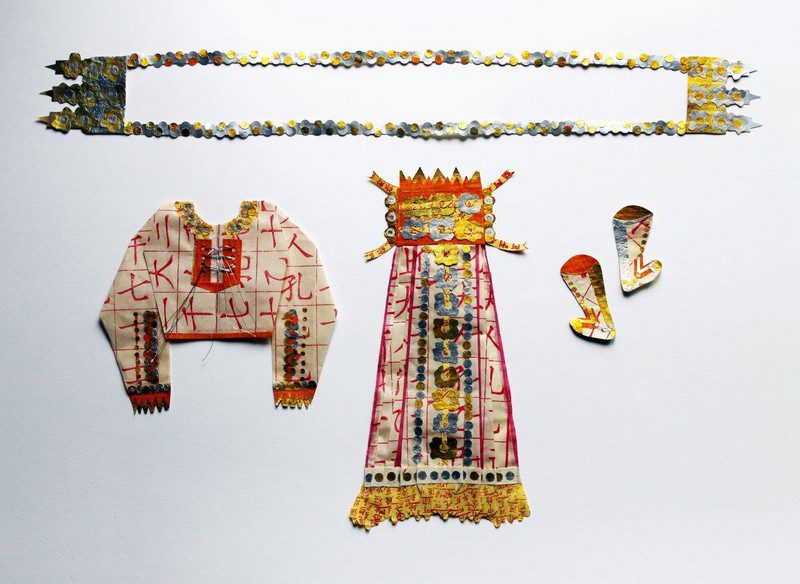
Blanka Amezkua: The opportunity to redefine a garment and to examine how it could have been worn by a human being, in a different period, was a beautiful invitation. Allow a flow of ideas and endless possibilities to reach the surface. I wanted to work with paper, because the paper and its touch, is similar to leather. The necklace of this dress was my favorite item to re-create. I’ve seen various traditional dresses in the museum of Greek Folk Art in Plaka, some of them were very expensive-decorated, and others were for celebrations and many others for weddings. And these dresses also incorporate this type of necklace, which is long and hangs from behind and from the front. A magnificent detail that is often discarded and not included in contemporary culture. By re-interpret parts of the original dress using Chinese paper, it was an attempt to become a witness to the interlacing of some major world civilizations, in this case the Greek and Chinese!
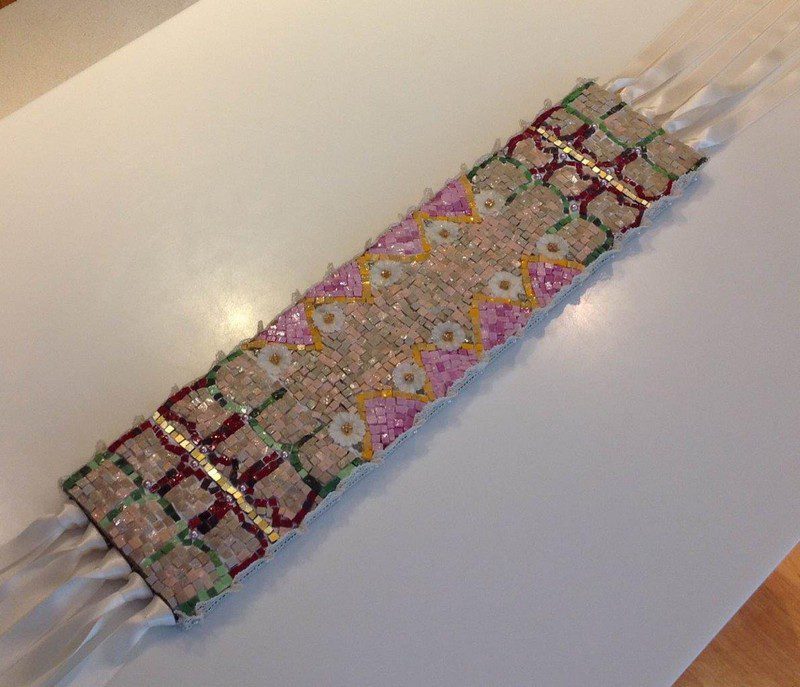
Despina Georgiadi Thessalonikeos: The idea of the curator Mina Karagianni, for this project, was pioneering and provoked our imagination. To inspire my artistic creation (detail from the headband). I closed my eyes and dreamed the costume of Mykonos by Pitton de Tournefort in the 18th century with its own colors. I wanted to create a mosaic, which would reflect the beauty and emotions of women of that era. At the same time, I was thinking that all the artists wanted to create a total that frames the original idea and simultaneously converse with the environment of the Katakouzenos House. The result justified us all.
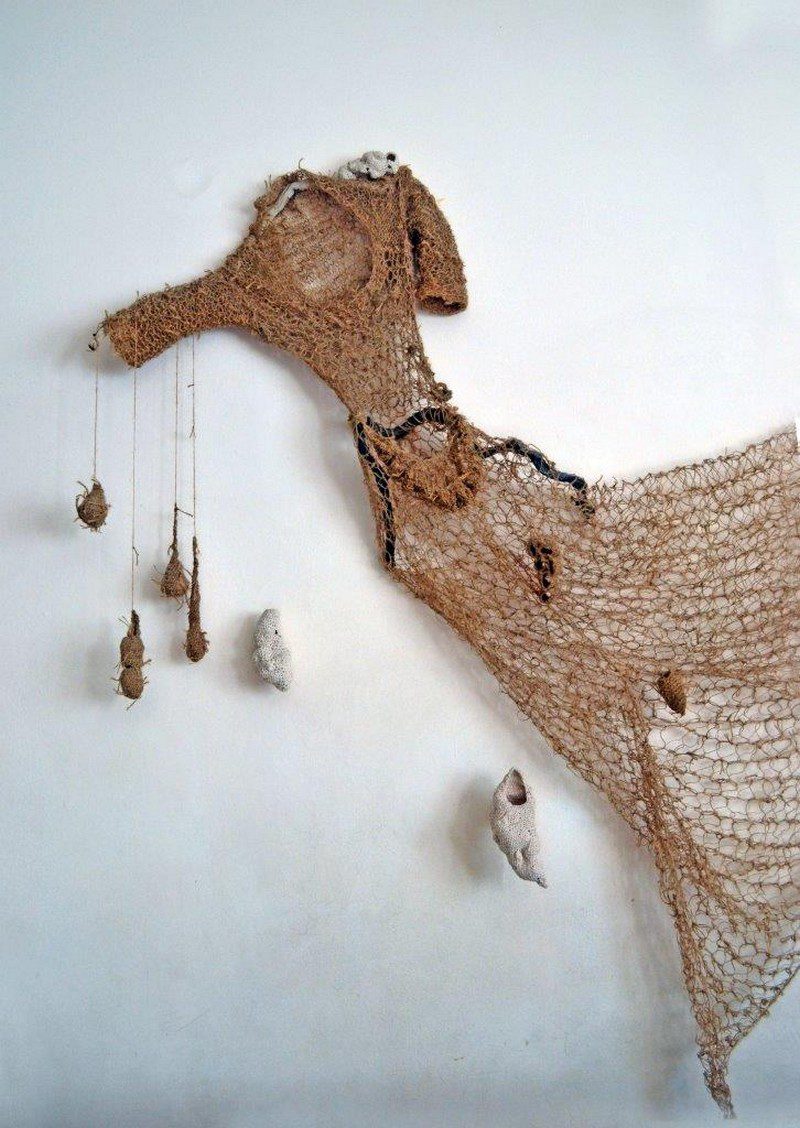
Stauroula Kaziale: From the first team meeting, I noticed that we all had the same enthusiasm for both the voyage we began, and for this particular space that would host our creations. As we began to draw material, by dipping in marriage contracts and other sources of the era, more and more, we touched our roots and began to emerge: inspiration and ideas. The aura of theKatakouzenos House, I think, it was the compass to find the crossroad, in which 18 different artistic proposals could meet. This co-sailing and its result was a pleasant surprise for me!
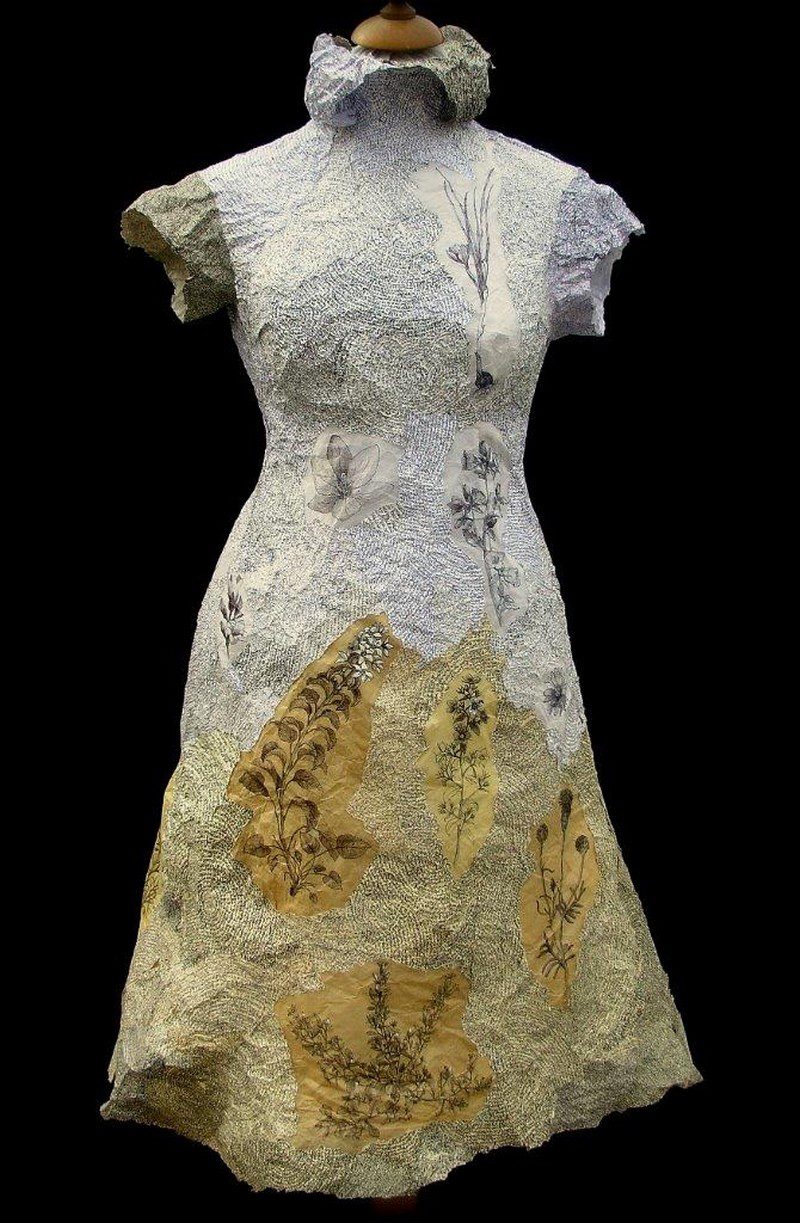
Eleni Angelou: The research for the creation of the exhibition’s artwork, was very pleasant experience to me, revealed details about the island and the habits of women that I did not knew. Our meetings in museums, but also at the actual exhibition space, was catalytic for the direction that eventually followed. I ended up in a dress made of paper with handwritten text and drawings. The small flowers sprouting in Mykonos Island and their Latin names, repeated in a circular pattern imprinted on the paper replacing the stitches would be needed for an embroidered costume. Everything in connection with the exhibition, from the concept and curating to the hospitality, the smooth cooperation and the harmonious coexistence of artworks in a special space, were excellent.
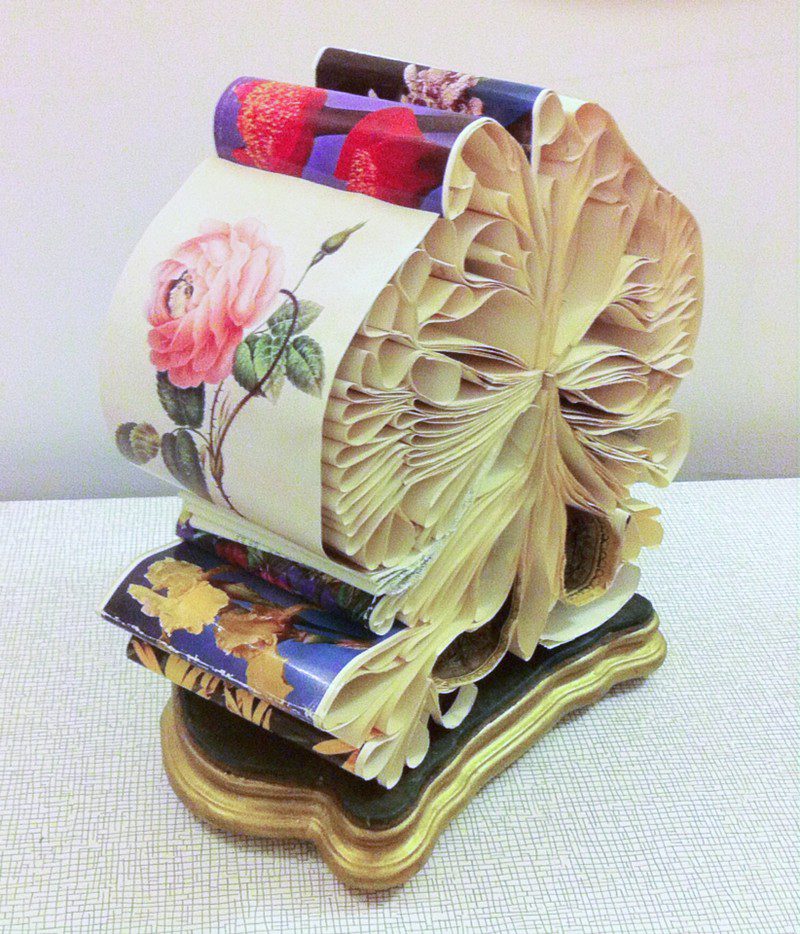
Christina Mitrentse: Both the research and the process of creating the artwork, were very pleasant during the 8 months. It was an approach in the exhibition, where the details of tradition and the connection of cultures co-exist. I was strongly influenced by the historic Katakouzineos House (I was probably the first of the artists who encouraged the curator to held the exhibition in this space), from the surrounding atmosphere of the office/library with sculptures, books, and humble souvenirs. The result is “Book-Votanofilo”, a “new” object of memory, an addition to the collection and inspiring space for dignitary European, American and Greek artists and scientists. A montage of botany and plant books from my international project “Add to my Library”, cut into flower shape, which are meticulously transformed into handmade organic “Book-friendly”. The Victorian wood carved base has references to the movement of Art-Nouveau and the historical and aesthetic elements of the costume of Mykonos, which recorded by the traveler, Joseph Pitton de Tournefort.
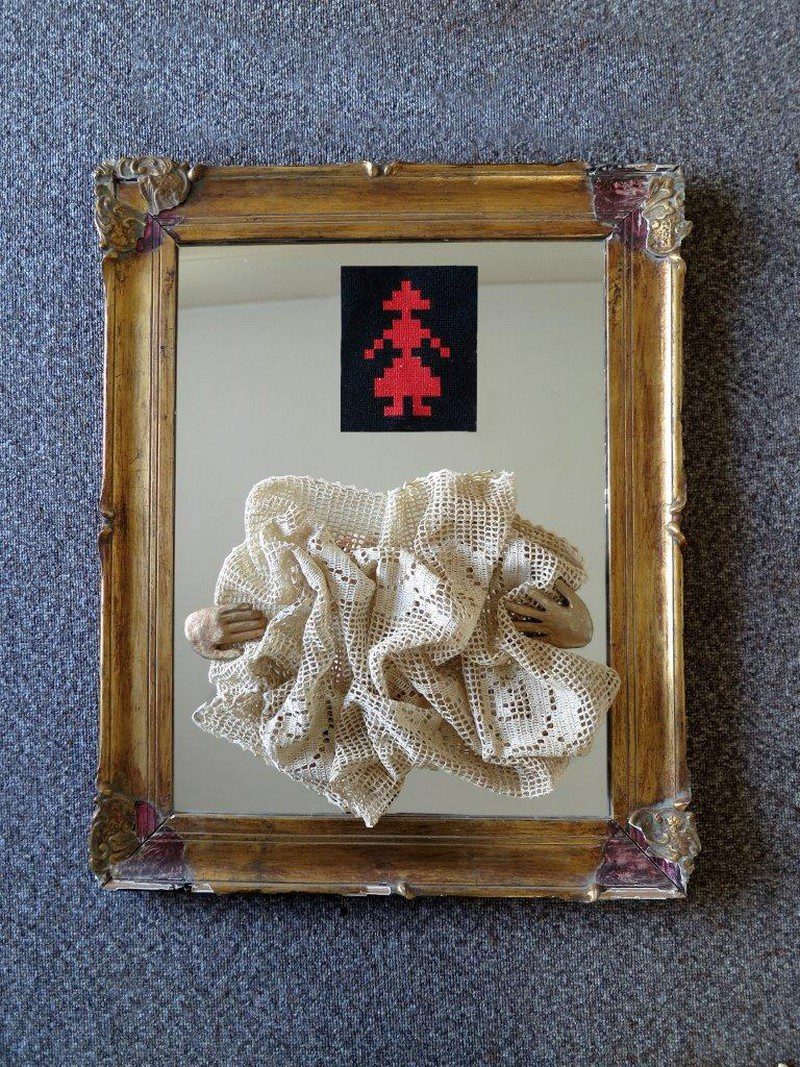
Artemis Alkalai: My work is related to the fabric, the embroidery, the weaving on the loom, the designing of handmade carpets and costumes for dance. Thus, the proposal of Mina Karayanni -with which I have already collaborated twice, to participate in this exhibition, could not be closer to the source of my interests. Giannis Metzikof, who had assumed the recreation of the beautiful Mykonian costume as well as the 18 women of the group. Are excellent artists with important body of work! The Angelos & Leto Katakouzenos Foundation is the ideal place for our artworks but also for the public! Cooperation harmonious, warm hospitality, memorable experience!
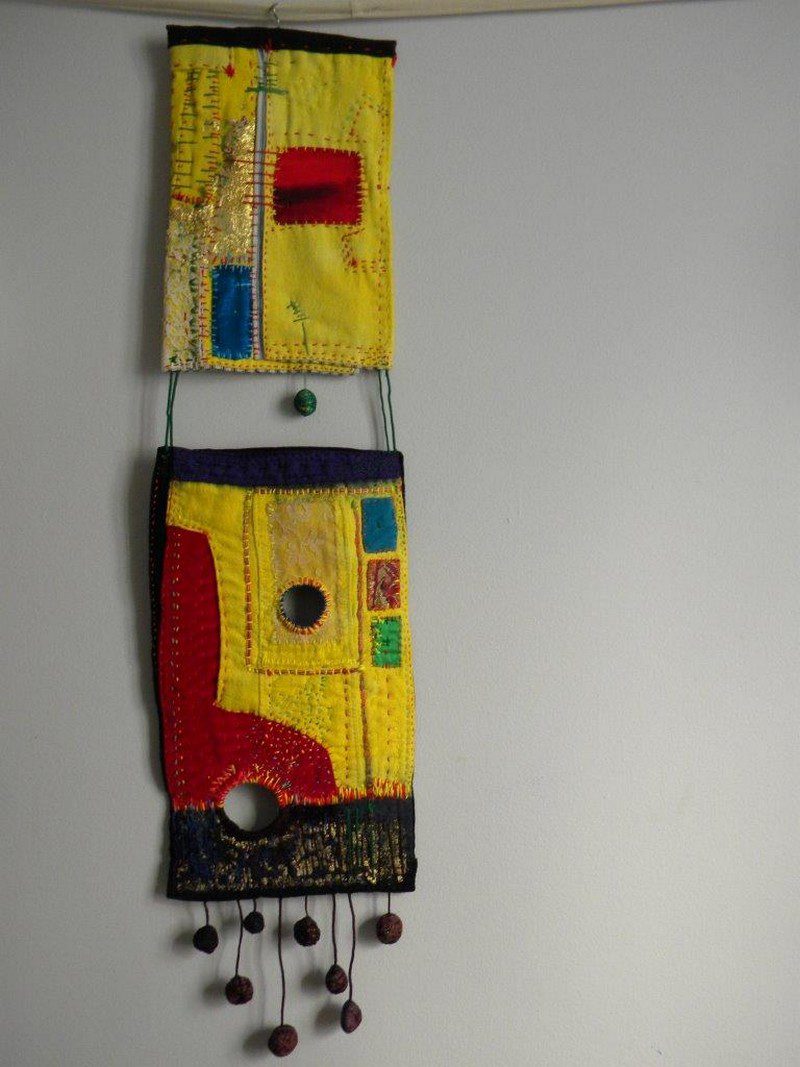
Anna Theocharaki: Most women make a single costume for their entire life.I am standing here and I am thinking about those days, the domestic economy but also the slow movement of time, the inconvenient, that in the narrow boundaries of tradition does not mean to change, to serve the practical side of life. The acceptable for the older, was the rule for the younger generations. What if the mules are uncomfortable and uninviting for walking is, what if the embroidery with gold thread marks the skin, women embroider and decorate their clothes, a fact that demonstrates the need for adornment but also the historical continuity. But “The dead had the need to fresh out again” as says in Contrabant, the famous Mykonian author, Melpo Axioti. So I kept the meditative dimension of working with the thread and needle, embroidered in my own way, I painted cloths woven on the loom and let their color to combine with the neighboring color, which we often find in old costumes. I created a hole, a symbol of escape from the typical and sometimes stifling uniformity. Finally, I chose the rectangle, a geometric shape safe and peaceful as a wish for the future.
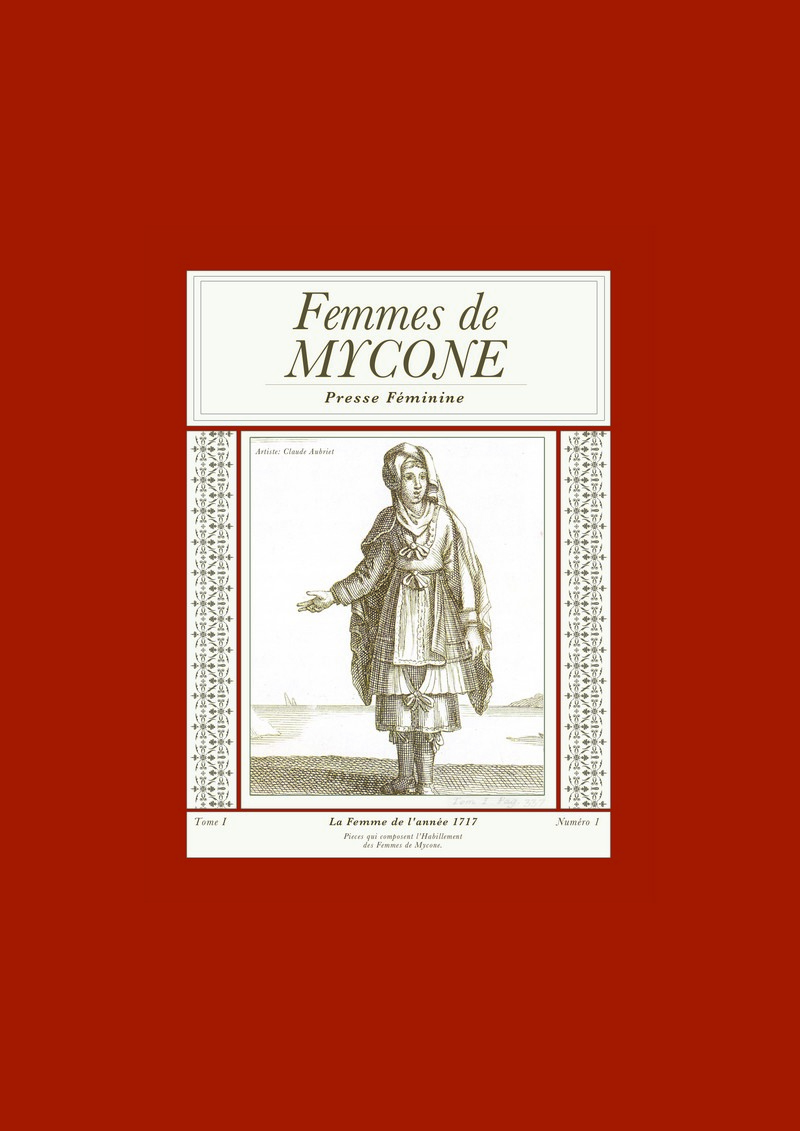
Efrosini Ellina: On the occasion of the engravings by the French Jozeph Pitton de Tournefort and attempting a game with time, connecting the past and now, I was wondering how the Mykonian ladies of the era would realize the style and fashion many years ago. These covers are a simulation of the press of that era, with contemporary magazines, that read and consult the contemporary women. Maintaining the style and the genre of each era, you can travel in fashion of female costume from 1717- 1840.
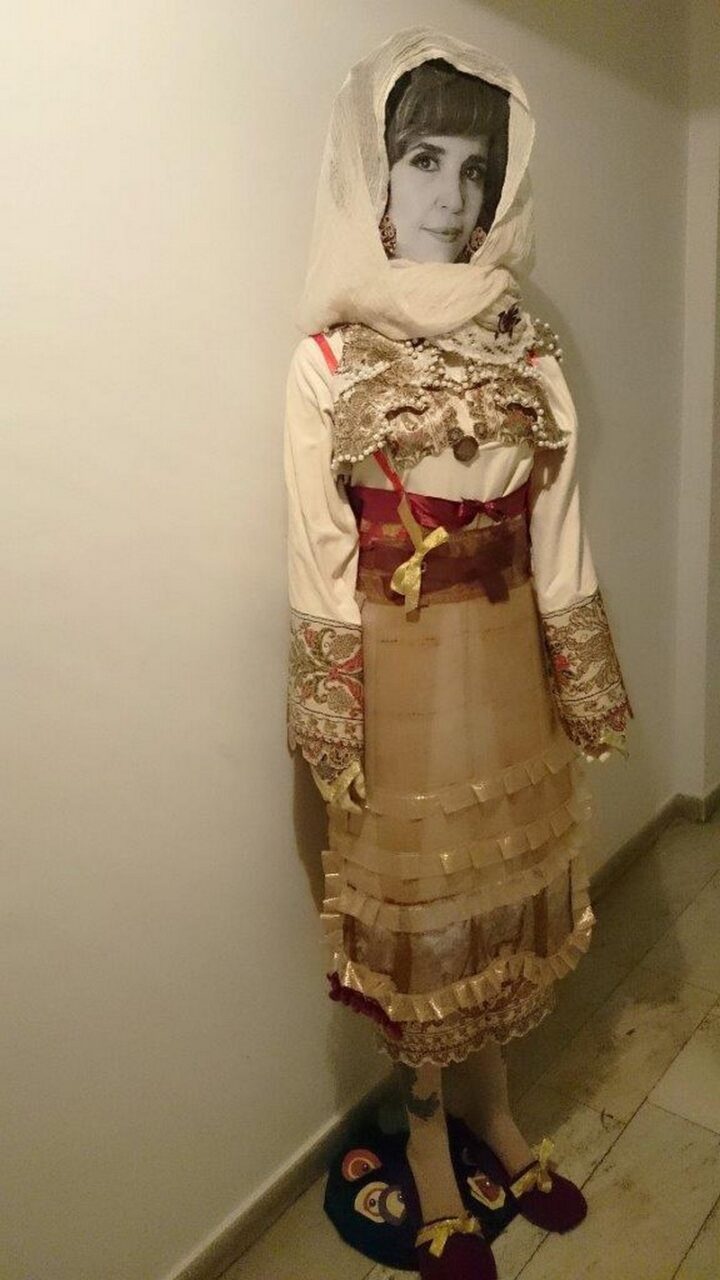
Chagia Koen: A woven of human relations, opened the door of my yard, for this journey. Together, a girl from the past, holding tickets in her apron. A girl with name. My Marouso. Measures, pattern, dress rehearsals designs. Chitchat from her black and white image, colored and ornaments the answers. She dived into the color and left behind her gray for me. I was dreaming this day, like today. With sunshine. To see her beautiful, svelte, in a rare house of Athens. First daughter of our house, among others recherché, to admire and facing us with sauciness. We wish her good luck.
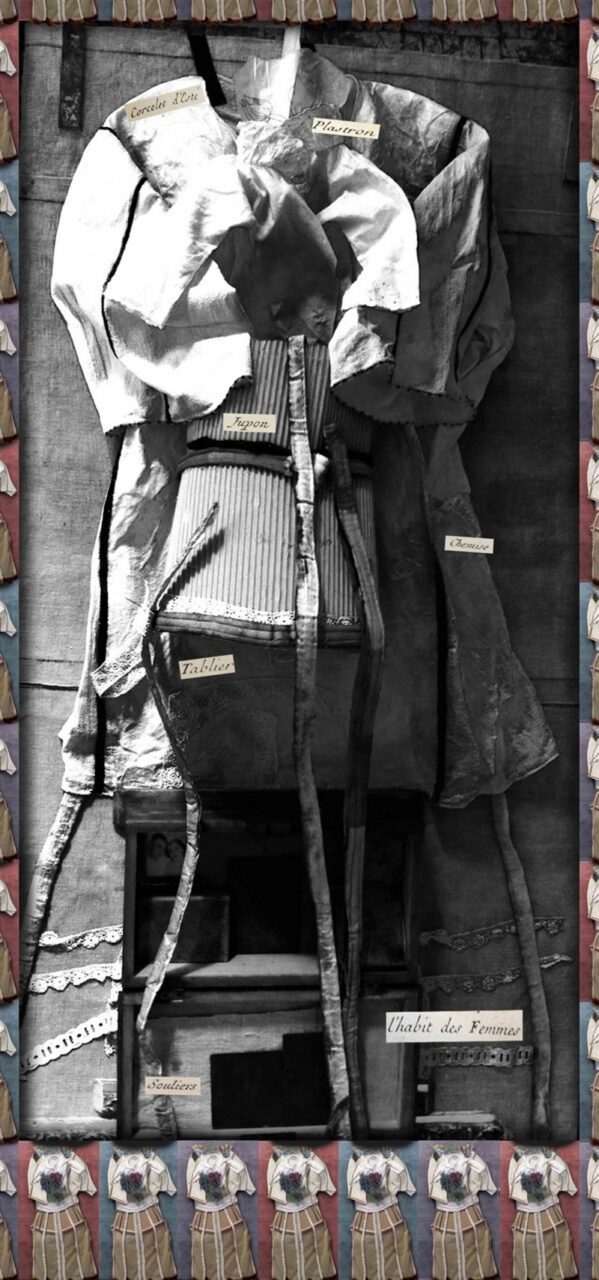
Eva Goulakou & Marilena Zampoura: With the Mykonian Costume as a stepping stone in our cooperation, we thought the manufacturing of the Costume that is transferred from generation to generation. Even if thee are staying in a closet or a chest, as some costumes or parts of costumes that my mother and Eva’s grandmother, Lena, had left. When we visited the elegant apartment of Katakouzineos, we chose the table with old black and white photos as a placement area of our work. Our common “Costume” has moved from construction to printing and his journey was photographed at different stages. The final artwork-digital photograph in plexiglass, is exhibited on the wall above the black and white photographs, our artwork is dominated by the black and white photographs that surround it, repeating the fabricated costume like colored fringes. Our intention is the contrast in the great elegance of the surrounding area, since this era in our country is not distinguished by great elegance. In the artwork also contributed: Periklis Goulakos and Nikos Pachis.
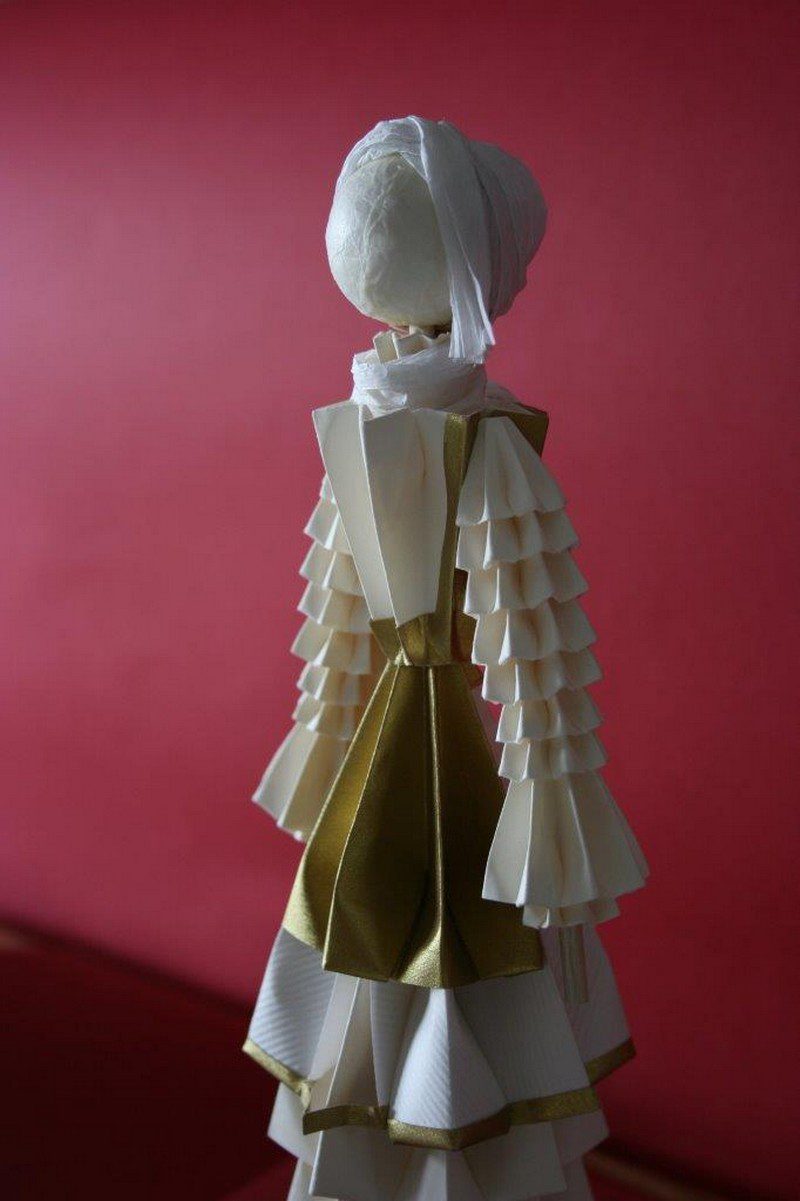
Katerina Christoforidi: I have read the Tournefort’s description. Again and again. I made a picture in my mind then I started to record the layers of the costume. Somewhere there began tests with textures, colors and sizes of paper. Every piece of paper, originally square, folded separately. Many individual papers of various sizes, which were the sleeve, the bodice, the overcoat. Each piece, one inside the other, trying to give the sense of the successive levels of a garment, without shown at first sight that the material is paper.The origami too, although created from paper, in its final form, usually deceives the eye.
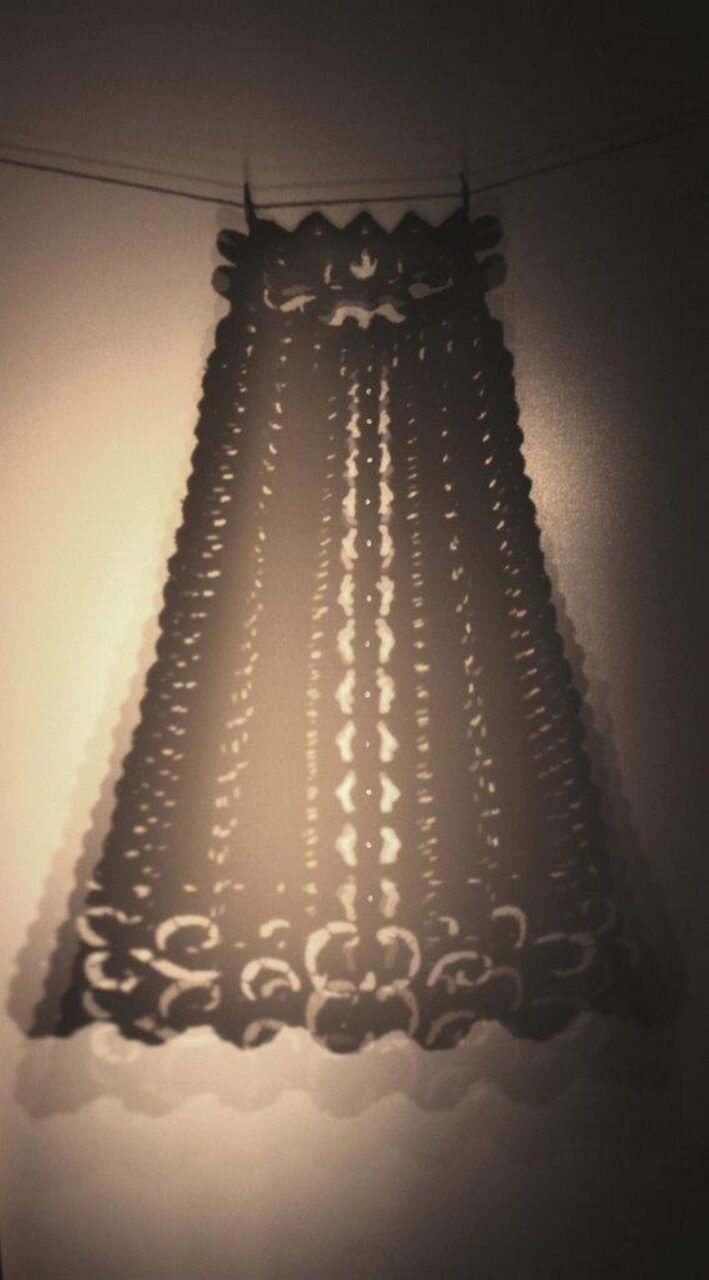
Efi Fouriki: Listening to the theme of the exhibition, and then through our discussions, began to come alive in my mind images of Mykonos and of the island where I grew up, Salamis. Studying the parts of the costume and wanting to have light and air, as basic “media” of my work, I decided to work with the apron, which in its innocence, acts as a bridge between the past and the present. I transferred the plan of engraving on paper, removing the points that would pass the light. My memories led me back to my island, to the old embroidery, to Mrs. Teresa Koklioti which embroidered the apron. With my artwork I expect to enliven a picture-memory of a layered apron that gently moves in the air.
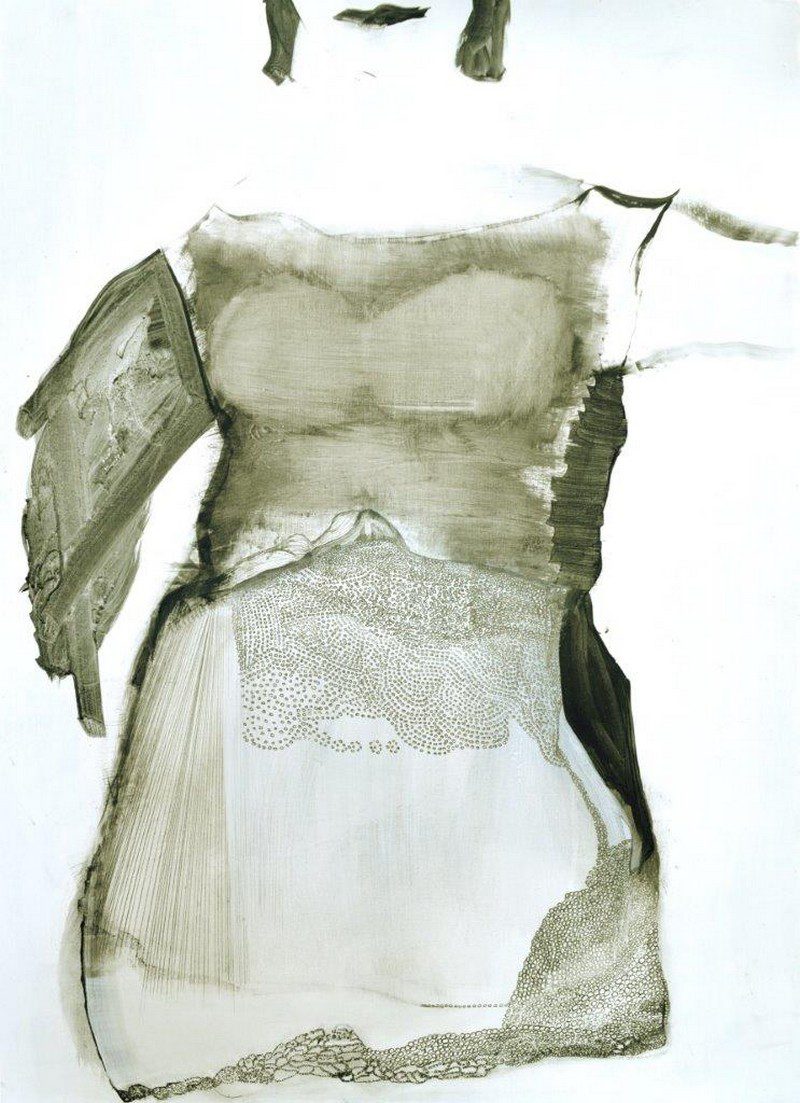
Spiridoula Politi: My desire to participate in this project, was great because the theme inspired also the fact that 18 women artists will process the same subject. During all this time, my creativity has intensified because Ι inspired by tradition and experience. In particular I’ve done a project with the bed linen of my dowry, which I embroidered and painted. What I got is how different we the artists are working on the same subject. I think that it is worth the curators to organize such projects, as Mina Karayanni (Congratulations), with the involvement of artists, because these projects carry the tradition in today.
* Participating Artists: E. Angelou, A. Alkalai, B. Amezkua, M. Vardopoulou, D. Georgiadis, G. Gremouti, E. Goulakou, E. Ellina, M. Zaboura, A. Theocharakis, S. Kaziale, M. Kassi, C. Koen, C. Mitrentse, E. Pavlopoulou, S. Politi, E. Fouriki, K. Chistoforides.
First Publication: www.dreamideamachine.com
© Interview – Efi Michalarou
Info: Women Clothes of Mykonos: A study in Aegean Material Civilization, Curating: Mina Karagianni, The Angelos & Leto Katakouzenos Foundation, 4 Amalias Str., Syntagma Square, Athens, Duration: 29/4-10/5/15, Days & Hours: Fri: 17:00-20:00, Sat-Sun: 12:00-15:00
Media Partner
www.dreamideamachine.com
